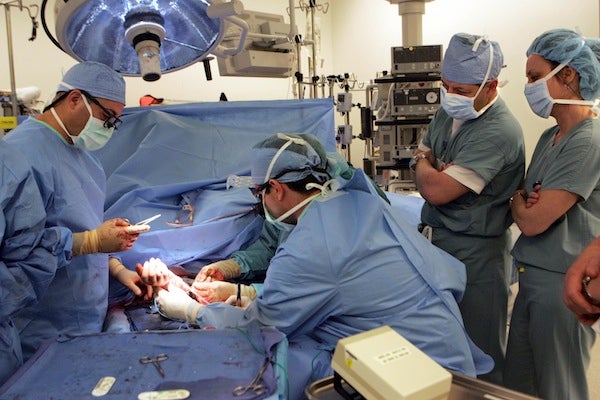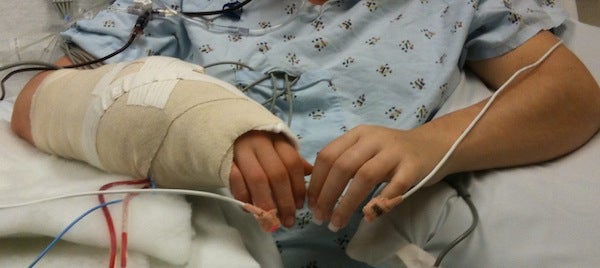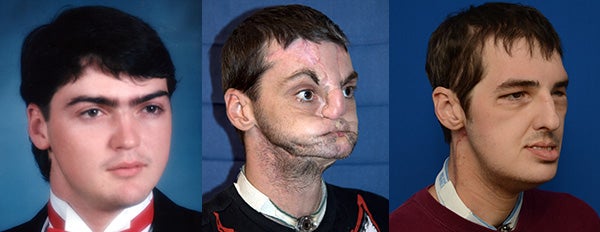This article was published in Scientific American’s former blog network and reflects the views of the author, not necessarily those of Scientific American
Recently as I listened to a Chicago morning talk radio station, the hosts, Eric and Kathy, asked listeners, “Whose head would you like to have?” in response to the news that a Russian man was contemplating a head transplant. Callers answered with famous people like Sandra Bullock and Ryan Reynolds.
While the grotesque and fanciful concept of head transplantation is compelling, other new, real forms of organ transplantation like face, hand and even uterus, are becoming more ordinary.
These new kinds of organ transplants are called vascularized composite allographs or VCAs. While they could be life-enhancing for people with congenital malformations or who lost body parts through trauma or war, there are many unknowns. Thus, as someone who researches ethical issues in organ transplantation, I have been grappling with the ethics of VCAs, which are in need of greater oversight.
On supporting science journalism
If you're enjoying this article, consider supporting our award-winning journalism by subscribing. By purchasing a subscription you are helping to ensure the future of impactful stories about the discoveries and ideas shaping our world today.
Here are some of the facts. When the Department of Health and Human Services decided in 2014 that VCAs should be overseen and allocated, like any other organ, by the Organ Procurement and Transplant Network and United Network for Organ Sharing -- the organization overseeing the national organ transplant allocation system, it also implicitly allowed living people to donate VCA tissues.

Dr. Kodi Azari (left) and members of his surgical team perform the first hand transplant in the western United States at Ronald Reagan UCLA Medical Center in Los Angeles, March 5, 2011. (Courtesy of UCLA Health System/Ann Johansson Photography)

Patient rests with new righ hand after surgeons performed the first hand transplant in the western United States at Ronald Reagan UCLA Medical Center in Los Angeles, March 5, 2011. (Courtesy of UCLA Health System)
But patients seeking a VCA transplant only have to wait days or weeks to receive one from a deceased donor, and VCAs don’t, biologically at least, save lives. So there isn’t much justification for donations from the living. Except that it does increase the pool of donors who might be needed in urgent cases. Otherwise, alternatives are limited, for example, for those who would like a new uterus—they could seek a deceased donor uterus or a surrogate mother.
When should living people donate? Without clear policy in place about living VCA donation, one might ask, “Could I donate my hand to my brother who came back from Iraq without one?” To quickly clarify these questions and set limits on the kinds of VCAs that living people may donate, the United Network for Organ Sharing asked its VCA, Living Donor, and Ethics committee experts, including me, to develop guidance for transplant centers on how to evaluate and obtain informed consent from people coming forward to become a living VCA donor.
Last month, the United Network for Organ Sharing Board of Directors approved the proposed guidelines. These guidelines say that living donations are not ethically permissible for VCAs like hands and faces that would generate dysfunction in the donor. However, living donors of abdominal wall, long bone, uterus or other tissues may be considered in case of urgent need for tissues.
I agree that there may be a compelling reason to consider a living VCA donor in these scenarios, but only if donors are well informed of the risks and benefits to themselves and to the recipients.
What are the risks and benefits to both donors and recipients? Only about 140 VCA transplants from deceased donors have ever occurred worldwide so we know little about how the recipients are faring. Recent studies of hand/upper extremity and face transplant recipients worldwide found that function and quality of life improved, although there are ethical concerns over exposing otherwise healthy individuals to adverse effects of lifelong anti-rejection medicine, which is necessary to prevent the body from rejecting the tissue.
Even less is known about living donor outcomes since living VCA donation has been virtually nonexistent until last year when a woman donated her uterus to her friend. Before this, there were a few cases of donation between identical twins where abdominal wall tissue was donated to reconstruct the breast after mastectomy, and tissue within the belly was donated to reconstruct the scalp.

The University of Maryland performed a full face transplant, including both jaws, teeth and tongue. The 36-hour operation occurred on March 19-20, 2012 at the R Adams Cowley Shock Trauma Center at the University of Maryland Medical Center and involved a multi-disciplinary team of faculty physicians from the University of Maryland School of Medicine and a team of over 150 nurses and professional staff. From left to right: the patient's high school prom photo, the patient before surgery, the patient 7 months after surgery. (Courtesy of University of Maryland Medical Center)
If we look at living kidney or liver donors, most do just fine after donating, but others have experienced bad outcomes post donation. For example, in living donors’ accounts of their experiences with donation, some experienced greater pain than expected, post-traumatic stress disorder, or did not feel well taken care of by the healthcare system despite having performed this generous act. Considering these outcomes after 369,000 kidney transplants in the United States since 1988, how well will VCA donors fare?
Ultimately, as the living donor, you decide what is in your own best interest. But with so little information about donor or recipient outcomes, potential donors cannot make informed treatment decisions. They may be motivated to donate solely based on their emotional relationship with the patient, as many studies show to be the case. It’s like someone who wants to donate long-bone tissue to a relative without knowing whether or not other living donors of long-bone tissue had incurred any leg dysfunction after donating.
While we need pioneer donors whose outcomes we learn from, we also urgently need other kinds of research such as on the quality of life before and after donating or receiving a VCA. Finding out what information potential living VCA donors need to know about donors’ and recipients’ outcomes is essential for improving the consent process to enable future donors to make informed decisions. Until this happens and living VCA donation is no longer considered experimental, greater oversight is needed to protect living donor safety.
While head transplants won’t be happening anytime soon, with other living VCA donation now permissible, it is only a matter of time before more people step forward to offer their tissues to patients in need. The healthcare system needs to be prepared to protect potential VCA donors by optimizing the informed consent process.